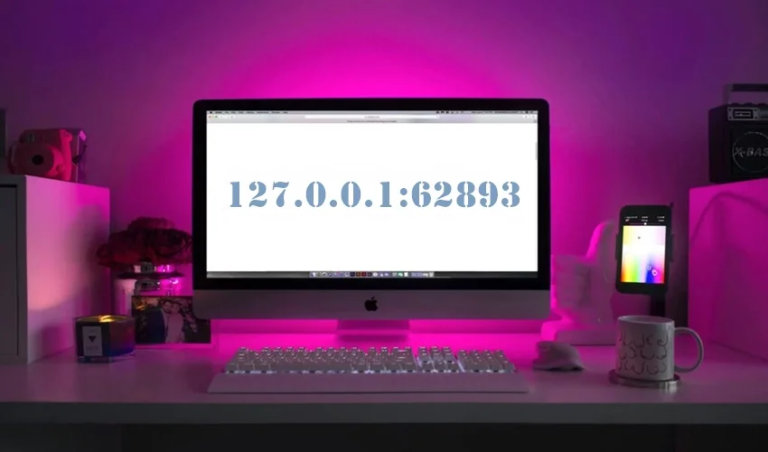Certain numbers and addresses are ubiquitous in networking and computer systems yet often misunderstood. One such combination is “127.0.0.1:62893.” This seemingly cryptic string holds significant meaning and utility in computing and networking.
To fully understand its relevance and impact, it’s essential to delve into its components, usage, and broader implications in today’s digital landscape.

Understanding the Basics: What is 127.0.0.1?
The IP address “127.0.0.1” is known as the loopback address. It is a unique address used by a computer to refer to itself. When you use this address, you tell the system to send the network traffic back to the same machine.
This is a critical part of networking, allowing for testing and development without sending data over the network.
The loopback address is part of the IPv4 range and is reserved for local communication within a computer.
Any packet sent to this address is looped back, bypassing the network interface hardware. This mechanism is crucial for diagnosing network issues, testing software, and ensuring that services run correctly on a local machine.
The Significance of Port 62893
In networking, a port is a virtual endpoint for data transmission. Ports allow multiple services to run on a single IP address by distinguishing between different types of network traffic. “62893” in “127.0.0.1:62893” refers to such a port.
Port numbers range from 0 to 65535 and are categorized into three types: well-known ports, registered ports, and dynamic or private ports. Well-known ports (0-1023) are assigned to widely used protocols and services.
Registered ports (1024-49151) are assigned to specific applications by the Internet Assigned Numbers Authority (IANA). Dynamic or private ports (49152-65535) are generally used for temporary purposes, often assigned dynamically by the operating system when a service needs a temporary port.
Port 62893 falls into the dynamic or private port range. It is typically used for temporary, private communication rather than being associated with a specific, well-known service. This means it could be used for various applications, especially during development or in specific local testing scenarios.
Practical Applications and Examples
Software Development and Testing
One primary use of “127.0.0.1:62893” is in software development and testing. Developers often test their applications locally before deploying them to production environments.
Using the loopback address in combination with a dynamically assigned port allows developers to simulate network communications without needing external network resources. For instance, a web server might be run locally on “127.0.0.1:62893” to test its functionality before making it accessible on the broader Internet.

Network Diagnostics
Network administrators and engineers use the loopback address for diagnostics and troubleshooting. By running services locally on addresses like “127.0.0.1:62893,” they can isolate problems within a system without external interference. This helps pinpoint issues related to specific applications or services running on a machine.
Educational Purposes
Understanding “127.0.0.1:62893” is fundamental for students learning about networking and computer science. Experimenting with loopback addresses and various ports can give students hands-on experience with IP addressing, ports, and network protocols.
Security Implications
Potential Risks
While “127.0.0.1” is designed for local use, it is not entirely free from security concerns. Misconfigured applications or services running on the loopback address might inadvertently expose sensitive information or functionalities. If a local service listening on “127.0.0.1:62893” is not secured correctly, it could be exploited by malicious software running on the same machine.
Best Practices
To mitigate risks, it is essential to follow best practices in securing applications and services that use loopback addresses. This includes:
- Proper Configuration: Ensure that services are correctly configured to listen only on the loopback address if they are meant for local use only.
- Access Controls: Implement strict access controls to limit who or what can interact with services running on “127.0.0.1:62893.”
- Regular Updates: Keep software and services up-to-date with the latest security patches and updates.
The Broader Impact on Networking
Evolution of IP Addressing
The concept of loopback addresses like “127.0.0.1” has evolved with the development of networking protocols. With the advent of IPv6, the loopback address has been expanded to “::1,” offering a broader range of local testing and diagnostics addresses. This evolution underscores the ongoing importance of loopback addresses in network design and management.

Influence on Internet Architecture
The loopback address and its associated ports have influenced the design and architecture of the Internet. By providing a reliable mechanism for local communication, they have enabled more robust and flexible network configurations. This has had a lasting impact on how network services are developed, tested, and deployed.
Conclusion
The string “127.0.0.1:62893” may seem esoteric at first glance, but it embodies fundamental principles of networking and computing. Understanding its components—the loopback address and the port—reveals a wealth of information about local communication, software development, network diagnostics, and security.
As we continue to rely on digital technologies, the importance of these essential building blocks becomes increasingly evident. By decoding the enigma of “127.0.0.1:62893,” we gain deeper insights into the inner workings of our digital world and the crucial role these elements play in shaping it.


